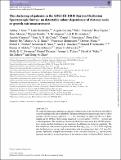The clustering of galaxies in the SDSS-III DR10 Baryon Oscillation Spectroscopic Survey : no detectable colour dependence of distance scale or growth rate measurements
Abstract
We study the clustering of galaxies, as a function of their colour, from Data Release Ten (DR10) of the Sloan Digital Sky Survey III (SDSS-III) Baryon Oscillation Spectroscopic Survey. DR10 contains 540 505 galaxies with 0.43 < z < 0.7; from these we select 122 967 for a ‘Blue’ sample and 131 969 for a ‘Red’ sample based on k + e corrected (to z = 0.55) r − i colours and i-band magnitudes. The samples are chosen such that both contain more than 100 000 galaxies, have similar redshift distributions and maximize the difference in clustering amplitude. The Red sample has a 40 per cent larger bias than the Blue (bRed/bBlue = 1.39 ± 0.04), implying that the Red galaxies occupy dark matter haloes with an average mass that is 0.5 log10 M⊙ greater. Spherically averaged measurements of the correlation function, ξ0, and the power spectrum are used to locate the position of the baryon acoustic oscillation (BAO) feature of both samples. Using ξ0, we obtain distance scales, relative to the distance of our reference Λ cold dark matter cosmology, of 1.010 ± 0.027 for the Red sample and 1.005 ± 0.031 for the Blue. After applying reconstruction, these measurements improve to 1.013 ± 0.020 for the Red sample and 1.008 ± 0.026 for the Blue. For each sample, measurements of ξ0 and the second multipole moment, ξ2, of the anisotropic correlation function are used to determine the rate of structure growth, parametrized by fσ8. We find fσ8, Red = 0.511 ± 0.083, fσ8, Blue = 0.509 ± 0.085 and fσ8, Cross = 0.423 ± 0.061 (from the cross-correlation between the Red and Blue samples). We use the covariance between the bias and growth measurements obtained from each sample and their cross-correlation to produce an optimally combined measurement of fσ8, comb = 0.443 ± 0.055. This result compares favourably to that of the full 0.43 < z < 0.7 sample (fσ8, full = 0.422 ± 0.051) despite the fact that, in total, we use less than half of the number of galaxies analysed in the full sample measurement. In no instance do we detect significant differences in distance scale or structure growth measurements obtained from the Blue and Red samples. Our results are consistent with theoretical predictions and our tests on mock samples, which predict that any colour-dependent systematic uncertainty on the measured BAO position is less than 0.5 per cent.
Citation
Ross , A J , Samushia , L , Burden , A , Percival , W J , Tojeiro , R , Manera , M , Beutler , F , Brinkmann , J , Brownstein , J R , Carnero , A , da Costa , L A N , Eisenstein , D J , Guo , H , Ho , S , Maia , M A G , Montesano , F , Muna , D , Nichol , R C , Nuza , S E , Sánchez , A G , Schneider , D P , Skibba , R A , Sobreira , F , Streblyanska , A , Swanson , M E C , Thomas , D , Tinker , J L , Wake , D A , Zehavi , I & Zhao , G 2014 , ' The clustering of galaxies in the SDSS-III DR10 Baryon Oscillation Spectroscopic Survey : no detectable colour dependence of distance scale or growth rate measurements ' , Monthly Notices of the Royal Astronomical Society , vol. 437 , pp. 1109-1126 . https://doi.org/10.1093/mnras/stt1895
Publication
Monthly Notices of the Royal Astronomical Society
Status
Peer reviewed
ISSN
0035-8711Type
Journal article
Description
LS is grateful to the European Research Council for funding. AB is grateful for funding from the United Kingdom Science & Technology Facilities Council (UK STFC). WJP acknowledges support from the UK STFC through the consolidated grant ST/K0090X/1, and from the European Research Council through the Starting Independent Research grant 202686, MDEPUGS.Collections
Items in the St Andrews Research Repository are protected by copyright, with all rights reserved, unless otherwise indicated.

